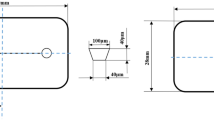Abstract
After entering the twenty-first century, there has been an ongoing drift toward miniaturization of discrete products in several areas. One such application is microfluidic device used in biomedical applications. The challenge with the manufacturing of microfluidic devices/biochips is that they often make use of broad range of materials within a single chip, making it difficult to manufacture these devices with conventional photolithographic-based techniques. Laser processing of materials has proved to be an important tool for the development of these devices because of the accuracy, flexibility, and the most important one material independence it offers. In this work, laser direct writing technique is used for the fabrication of microfeatures in AISI 1045 steel for the microfluidic applications. The basic purpose of the research work is to assess the performance of direct laser machining for the development of microfluidic channels by investigating the effects of different process parameters using design of experiments (DOE) and regression modeling analysis. The model is developed with Optimal Design IV in Response surface methodology taking five input parameters including the scan strategy which is mostly overlooked in the past research. Analysis of variance (ANOVA) has been carried out for five performance measures namely width error for rectangular section, width error for semicircular section, taper degree, recast layer, and material removal rate. Multiobjective optimization of these performance variables has been carried out, and it has been shown that optimized solutions are obtained at moderate frequencies, high scan speed, and minimum layer thickness.
Similar content being viewed by others
References
Yilbas BS (1997) Parametric study to improve laser hole drilling process. J Mater Process Technol 70:264–273
Zhang GF, Zhang B, Deng ZH, Chen JF (2007) An experimental study on laser cutting mechanisms of polycrystalline diamond compacts. CIRP Annal Manuf Technol 56:201–204
Qi J, Wang KL, Zhu YM (2003) A study on the laser marking process of stainless steel. J Mater Process Technol 139:273–276
Campanelli SL, Ludovico AD, Bonserio C, Cavalluzzi P, Cinquepalmi M (2007) Experimental analysis of the laser milling process parameters. J Mater Process Technol 191:220–223
Dubey AK, Yadava V (2008) Laser beam machining—a review. Int J Mach Tool Manuf 48:609–628
Rizvi NH, Apte P (2002) Developments in laser micro-machining techniques. J Mater Process Technol 127:206–210
Chen K, Yao YL (2000) Process optimisation in pulsed laser micromachining with applications in medical device manufacturing. Int J Advance Manuf Technol 16:243–249
Ghoreishi M, Low DKY, Li L (2002) Comparative statistical analysis of hole taper and circularity in laser percussion drilling. Int J Mach Tool Manuf 42:985–995
Almeida IA, de Rossi W, Lima MSF, Berretta JR, Nogueira GEC, Wetter NU, Vieira ND Jr (2006) Optimization of titanium cutting by factorial analysis of the pulsed Nd:YAG laser parameters. J Mater Process Technol 179:105–110
Mathew J, Goswami GL, Ramakrishnan N, Naik NK (1999) Parametric studies on pulsed Nd:YAG laser cutting of carbon fibre reinforced plastic composites. J Mater Process Technol 89–90:198–203
Chen YH, Tam SC, Chen WL, Zheng HY (1996) Application of the Taguchi method in the optimization of laser micro-engraving of photomasks. Int J Mater Prod Technol 11:3–4
Pham DT, Dimov SS, Petkov PV (2007) Laser milling of ceramic components. Int J Mach Tool Manuf 47:618–626
Yousef BF, Knopf GK, Bordatchev EV, Nikumb SK (2003) Neural network modeling and analysis of the material removal process during laser machining. Int J Advance Manuf Technol 22:41–53
Stavropoulos P, Chryssolouris G (2007) Molecular dynamics simulations of laser ablation: the Morse potential function approach. Int J Nanomanufact 1:736–750
Stavropoulos P, Stournaras A, Salonitis K, Chryssolouris G (2010) Experimental and theoretical investigation of the ablation mechanisms during femptosecond laser machining. Int J Nanomanufact 6:55–65
Li D (ed) (2008) Microfluidic analysis system. In: Encyclopedia of microfluidics and nanofluidics. Springer, US, pp 1136–1136
Song S, Lee KY (2006) Polymers for microfluidic chips. Macromolecul Res 14:121–128
Reyes DR, Iossifidis D, Auroux P-A, Manz A (2002) Micro total analysis systems. 1. Introduction, theory, and technology. Anal Chem 74:2623–2636
Marty F, Rousseau L, Saadany B, Mercier B, Français O, Mita Y, Bourouina T (2005) Advanced etching of silicon based on deep reactive ion etching for silicon high aspect ratio microstructures and three-dimensional micro-and nanostructures. Microelectron J 36:673–677
Okandan M, Galambos P, Mani SS, Jakubczak JF (2001) Development of surface micromachining technologies for microfluidics and BioMEMS. Micromachining and Microfabrication, International Society for Optics and Photonics. 133–139
Sahli M, Millot C, Gelin JC, Barrière T (2013) The manufacturing and replication of microfluidic mould inserts by the hot embossing process. J Mater Process Technol 213:913–925
Zeng H, Martella D, Wasylczyk P, Cerretti G, Lavocat JCG, Ho CH, Parmeggiani C, Wiersma DS (2014) High‐resolution 3D direct laser writing for liquid‐crystalline elastomer microstructures. Adv Mater 26:2319–2322
Design-Expert® User Manual (2013) State-Ease, Inc.,www.statease.com/dx9.html
Montgomery DC (2008) Design and analysis of experiments. John Wiley & Sons
Optimization, MOGA-II (2014) Mode Frontier V 4.0, User Manual. Esteco SPA
Author information
Authors and Affiliations
Corresponding author
Rights and permissions
About this article
Cite this article
Mohammed, M.K., Al-Ahmari, A. & Umer, U. Multiobjective optimization of Nd:YAG direct laser writing of microchannels for microfluidic applications. Int J Adv Manuf Technol 81, 1363–1377 (2015). https://doi.org/10.1007/s00170-015-7291-z
Received:
Accepted:
Published:
Issue Date:
DOI: https://doi.org/10.1007/s00170-015-7291-z




